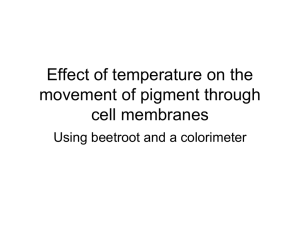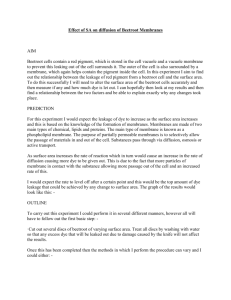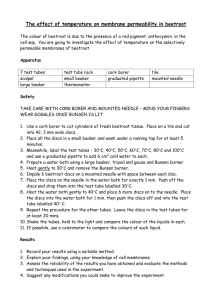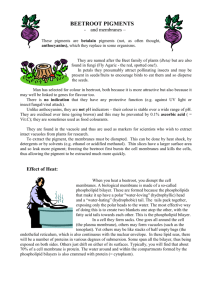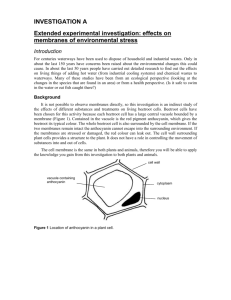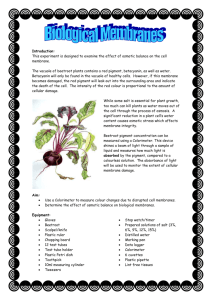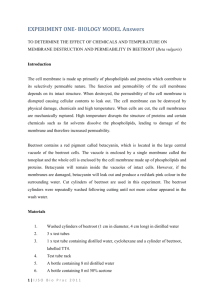Beetroot Experiment Report by Reetaza 311.doc
advertisement
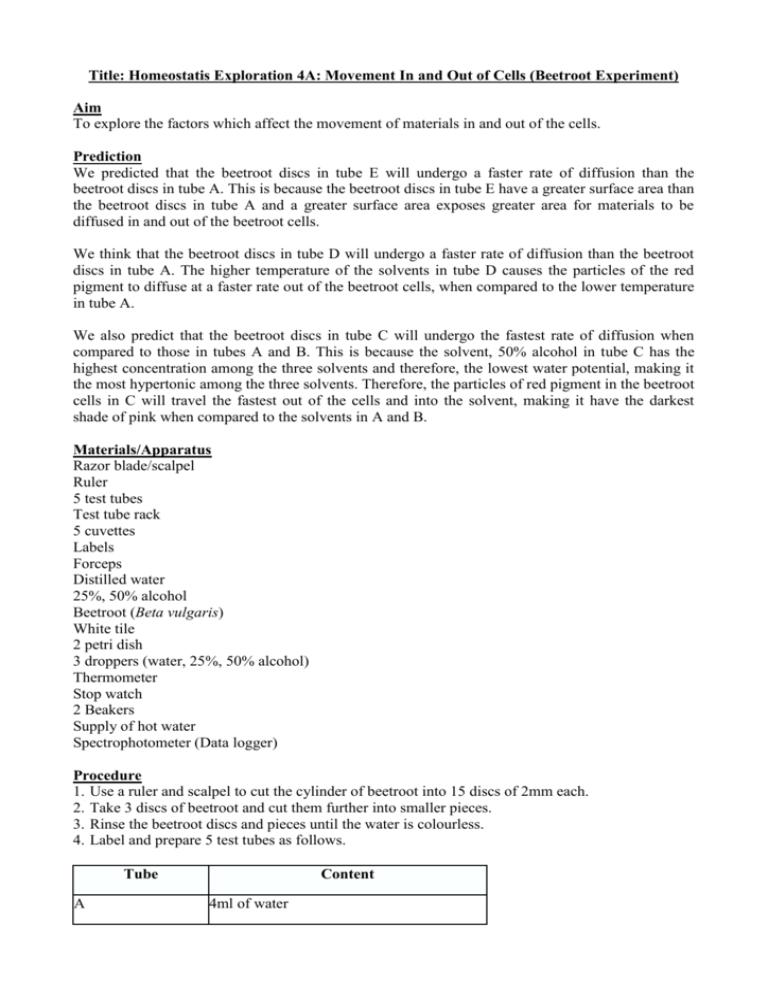
Title: Homeostatis Exploration 4A: Movement In and Out of Cells (Beetroot Experiment) Aim To explore the factors which affect the movement of materials in and out of the cells. Prediction We predicted that the beetroot discs in tube E will undergo a faster rate of diffusion than the beetroot discs in tube A. This is because the beetroot discs in tube E have a greater surface area than the beetroot discs in tube A and a greater surface area exposes greater area for materials to be diffused in and out of the beetroot cells. We think that the beetroot discs in tube D will undergo a faster rate of diffusion than the beetroot discs in tube A. The higher temperature of the solvents in tube D causes the particles of the red pigment to diffuse at a faster rate out of the beetroot cells, when compared to the lower temperature in tube A. We also predict that the beetroot discs in tube C will undergo the fastest rate of diffusion when compared to those in tubes A and B. This is because the solvent, 50% alcohol in tube C has the highest concentration among the three solvents and therefore, the lowest water potential, making it the most hypertonic among the three solvents. Therefore, the particles of red pigment in the beetroot cells in C will travel the fastest out of the cells and into the solvent, making it have the darkest shade of pink when compared to the solvents in A and B. Materials/Apparatus Razor blade/scalpel Ruler 5 test tubes Test tube rack 5 cuvettes Labels Forceps Distilled water 25%, 50% alcohol Beetroot (Beta vulgaris) White tile 2 petri dish 3 droppers (water, 25%, 50% alcohol) Thermometer Stop watch 2 Beakers Supply of hot water Spectrophotometer (Data logger) Procedure 1. Use a ruler and scalpel to cut the cylinder of beetroot into 15 discs of 2mm each. 2. Take 3 discs of beetroot and cut them further into smaller pieces. 3. Rinse the beetroot discs and pieces until the water is colourless. 4. Label and prepare 5 test tubes as follows. Tube A Content 4ml of water Tube Content B 4ml of 25% alcohol C 4ml of 50% alcohol D 4ml of hot water (90°C - 100°C) E 4ml of water 5. Place 3 discs of beetroot in tube A - D and all the chopped beetroot in E using the forceps. 6. Leave the tubes to stand in the test tube rack for 15 minutes. 7. In the interim of 15 minutes, switch on the data logger and launch MultiLabCE by clicking the MultiLabCE icon on the screen. 8. Plug the colorimeter into sensor port I/O-1 of the data logger. 9. Click the “setup” icon and click the “samples” tab. Scroll down and choose the “continuous” option. 10. Click “ok” at the top right side of the setup screen. 11. Fill a cuvette with water up to the mark. 12. Place the cuvette in the colorimeter and hold the cap close. Make sure the sides of the cuvette are dry before inserting into the colorimeter. 13. Click the “run” icon and twist the knob at the front of the colorimeter, adjusting such that the screen registers 100%. This is to calibrate the machine by using water that allows 100% of the light to pass through. 14. Press the red “hand” buttons that appears in place of the “run” icon in order to stop the experiment. 15. Shake the test tubes gently after 15 minutes and hold it against the white tile to note the colour. Record the observations in a table. 16. Decant a small amount of liquid from each test tube into a cuvette each. 17. Place the cuvette containing the liquid from A into the colorimeter. 18. Click the “run” icon again and record the value of light transmission once the value is relatively steady. 19. Repeat steps 17 and 18 for the rest of the cuvettes and record the results in a table. Table of Results Tube Content Colorimeter/ % Appearance of Solvent A 4ml of distilled water 90.75 Almost transparent B 4ml of 25% alcohol 81.50 Faint pink in colour C 4ml of 50% alcohol 24.50 Dark shade of red D 4ml of hot water (90OC100OC) 89.75 Faint pink in colour however the shade of pink is lighter than B E 4ml of distilled water 89.75 Faint pink in colour, however the shade of pink is lighter than B but darker than D Discussion Questions for Beetroot Experiment 1. What was the control in this activity? The control of this activity is the beetroot in tube A that is submerged in 4ml of distilled water. A scientific control is used in the experiment to minimize the influence of other variables in the same experiment and for the purpose of comparison. 2. How do you analyze the results of this experiment one variable at a time? There are three variables being measured in the experiment. The beetroots submerged in tubes A and D are used to compare the effect of temperature on the movement of materials in and out of the beetroot cells through the process of osmosis. The beetroots submerged in tubes A and E are used to compare the effect of surface area on the movement of materials in and out of the beetroot cells. At the same time, the beetroots submerged in tubes A, B, and C are used to compare the effect of the difference in percentage of the solvent in the rate of diffusion and the how fast the materials moved in and out of the beetroot cells. 3. Why was it necessary to wash the beetroot slices thoroughly before using them in this exploration? I think it is necessary to wash the beetroot slices thoroughly before using them so that the excess pigment can be removed for easier comparison later on. This ensures that the influence of other variables are minimized so that the results of the experiment are more reliable. 4. The main source of error in any biological experiment is usually the natural variation of living things. What did you do to ensure that this variation was minimized? In order to minimize this variation, the same stem of beetroot was used to cut out the beetroot discs. Different beetroots might have different amounts of red pigment in their cells and the addition of this extra variable might cause the comparison to be unfair. 5. Does alcohol have an effect on beetroot cell membranes? Was the concentration of alcohol a factor too? Suggest an explanation for your observations. Beetroot cells contain a red pigment, called belatin that is found within the vacuole of the beetroot cells. The pigment remains intact within the cell if the cells are not “stressed” by the external environment. The red pigment leaks out of the cells if their membranes are damaged or altered. Cell membranes are made up of a bilayer of phospholipids, which also contains proteins. Some are found in the inner or outer layer and some span the whole membrane . Carbohydrate chains attach themselves to the external membrane forming glycoproteins and glycolipids. Alcohol is a fat solvent; it dissolves the fat in the cell membrane so the cell membrane becomes disintegrated. The beetroot discs in tube E experienced a faster rate of diffusion than the beetroot discs in tube A. This is because the beetroot discs in tube E have a greater surface area to volume ratio than the beetroot discs in tube A. A greater surface area exposes greater area for materials (red pigment) to be diffused out of the beetroot cells. Evidence of this can be found in our qualitative results, that would be our observations. The observations showed that the solvent in A was of a lighter shade of pink that the solvent in E and this could be because more red pigment leaked out from the beetroot cells and diffused in solvent E than that in A. The percentages for the amount of light that passed through for A was 90.75% while that for E was 89.75%, showing that the shade of pink for E was darker than that of A. The beetroot discs in tube D experience a faster rate of diffusion than the beetroot discs in tube A. The higher the temperature, the greater the amount of kinetic energy in the particles of red pigment in the beetroot cells and the faster they diffuse out of the cells. The higher temperature of the solvents in tube D causes the particles of the red pigment to diffuse at a faster rate out of the beetroot cells because of the increased amount of kinetic energy in the particles of red pigment. Our observations tell us that while the solvent in A was almost transparent at the end of the experiment, the solvent in D had a light shade of pink. This shows that more particles of the red pigment leaked out of the beetroot cells and diffused in solvent D than in A. The percentages for the amount of light that passed through for A was 90.75% while that for D was 89.75%, showing that the shade of pink for D was darker than that of A. The beetroot discs in tube C experienced the fastest rate of diffusion when compared to those in tubes A and B. This is because the solvent, 50% alcohol in tube C has the highest concentration among the three solvents and therefore, the lowest water potential, making it the most hypertonic among the three solvents. Therefore, the particles of red pigment in the beetroot cells in C will travel the fastest out of the cells into the solvent (external environment). The percentages of the amount of light that passed through for C was 24.50%, while that for A and B were 90.75% and 81.50% respectively. Since the least light passed through solvent C, it had the darkest shade of pink, showing that more particles of red pigment leaked out of the beetroot cells to diffuse into solvent C. This is supported by our observations which showed that C had the darkest shade of pink, followed by B and then A. 6. Suggest an explanation for your observations of tubes D and E too. From the table of results, we are able to see that the percentage for the amount of light that passed through for tubes D and E are 89.75% and equal. This could be because the rate of diffusion was speeded up in both tubes. In tube D, the high temperature of the solvent caused the particles of red pigment in the beetroot cells to gain greater kinetic energy and diffuse faster into the solvent. Likewise, in tube E, the greater surface area to volume ratio of the beetroot cells caused diffusion of the red pigment from the cell to the solvent to carry out faster because of greater exposed surface area, allowing greater opportunities for diffusion to take place. 7. What are factors you can think of that would affect the leaking of the pigment out of the beetroot cells? The damage caused to the beetroot cell membranes was due to the cutting of the beetroot stems and submerging the beetroot discs in the alcohol. These could have caused the leaking of the pigment out of the beetroot cells through the process of passive transport that is, osmosis. Errors - Decanting was not done at the same time for all the test tubes at the end of the experiment and the pigment of the beet root could continue leaking. - The amount of solvent in each of the test-tube was estimated to be 4ml and not measured. This might have caused the amount of solvent in each of the test-tubes to be unequal. - Even though measures were taken to ensure that excess red pigment from the beetroots were rinsed and washed away when they were cut, not all of the excess red pigment might have been removed due to human error. Conclusion Surface area to volume ratio, percentage of solvent concentration and temperature are factors which affect the rate of diffusion. A larger surface area to volume ratio causes a faster rate of diffusion. The higher the concentration of the solvent, the lower its water potential, and the faster the process of osmosis can take place (and it will lose the greatest number of molecules of red pigment to its external environment, that would be the solvent). A higher temperature leads to a higher rate of diffusion due to the increased amount of kinetic energy. Done By: Reetaza Chatterjee (19) Class 311
